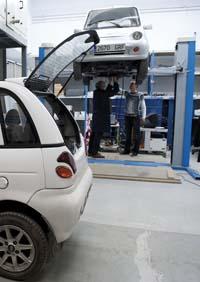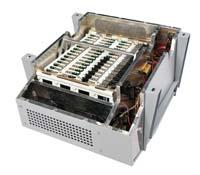Yes, but...

All the agents who work with electric cars look at the batteries today. As Igor Cantero, Cegasa's R&D director, states, "batteries are the determining factor of electric cars." The batteries greatly define the characteristics of the cars, such as their autonomy, acceleration capacity, charging time, etc.
Most experts say that the current batteries are insufficient to meet the needs of electric cars. In fact, the most used batteries now in electric cars are those of nickel metal hydride, like those of mobile phones and laptops years ago.
Later, lithium-ion devices were introduced, which gave many better features and capabilities, and now only lithium ones are seen. Well, the introduction of lithium batteries in electric cars has gone from a range of 60-80 kilometers to a range of 150 kilometers. From now on, lithium ion batteries will have a slower development. "Now the batteries can reach 150 watts per kilogram and the intention is that in the coming years there will be 200 watts per kilogram," explains Cantero.

This advance will not be enough for the electric car to reach the autonomy of the combustion cars, since with current energy densities batteries of one ton would be needed. But it's not about that. The objective of the researchers is to achieve an autonomy of between 200 and 250 kilometers, "sufficient autonomy for those who carry out daily routes of one hundred kilometers", said I. Madina, head of the industrial area of Cegasa.
They propose to use hybrid cars for longer trips. There are currently only parallel hybrid cars on the market, according to Mikel Uribe, by Mondragón Automoci n, which have an electric and combustion engine and acquire traction force from one engine or another. Soon we will have hybrids of another technology, as Uribe has advanced: hybrids that work in series. The electric motor will always be responsible for the traction and the non-electric motor will be supplying power to the battery.
In Cegasa they want to take a step forward, and those last hybrid cars would also want to be "zero emission" in the future. How? With hydrogen batteries that have been left behind in the race of alternative technology to oil. As Cantero explained, "it's about hydrogen batteries being the ones that supply hybrid car batteries."
Increasing safety and security

Another aspect very related to lithium batteries is that of safety. A few years ago it was heard a lot that the batteries of some electronic gadgets were heated and exploded. In electric cars the problem would be huge, considering that the batteries exceed 150 kilos.
"The explosion problems are overcome," explains I aki Madina. The materials with explosion problems have been replaced by much more secure, providing the batteries with special cooling systems to cope with possible temperature increases.
Overcome the problems of explosion, we are now studying the "location" of batteries in the car. "The battery must be located in a safe place in the car," explains Canterok-, "so many safety measures should be taken as passenger places, so that in case of accident the energy of impact does not damage the battery."
Price, problem pending

Once the batteries meet the needs of the cars, and overcome the security problems, the next problem to solve them will be the price of lithium batteries. Because it is not a nonsense: the batteries cost between 6,000 and 15,000 euros.
Lithium batteries for automobiles are today much more expensive than those of nickel hydride metal. The reason is that very few lithium batteries are manufactured for cars, and in small quantities much more expensive than those of nickel. However, as the production increases, the production of lithium is more encompassed than the production of nickel and, from a given moment, they become cheaper than those of nickel. This is what happened with small electronic devices, and that's why all electronic devices have lithium batteries.
Electric cars are creating the first cars with lithium battery. "But we have no doubt that in the coming years the batteries of the electric cars will be lithium--said Canterok-, and therefore, they will be much cheaper." The Japanese Ministry of Economy, Trade and Industry, for example, has set the goal for 2030 to reach 40% of the current cost of batteries. It should be noted that Japan is currently the most advanced country in electric cars.
Besides the batteries you have to investigate
Apart from batteries, electric cars have basically two other components: the engine and the converter. The battery provides energy, the motor moves and the converter adapts the amount of energy that must pass from the battery to the engine; by accelerating more, by slowing down, less... the driver presses the accelerator or the brake, but the true coordination is done by the converter.

"The rest of the components of electric cars are quite developed with respect to batteries; there will always be things to improve, but they are very advanced," says Ibon Ajuria, electronics technician at Mondragon Unibertsitatea.
Electric motors are used in many other sectors, being the most developed in recent years in the field of machine tool. It is then "easy to do: adapt the technology so developed for the automotive industry," says Mikel Uribe of Mondragon Automoci.
Although machine tool engines are very advanced, for use in automotive should be redesigned: "The power and turns of machine tool engines are too small for those who need cars," explains Uribe.
Well, both researches related to the engine and the converter, as well as improvements in terms of batteries, are investigations and developments that must be carried out quickly so as not to go back in the market of electric cars. As Igor Cantero said, "We are carrying out the projects. In 2-3 years we have to be able to build cars that meet the needs of the market".





